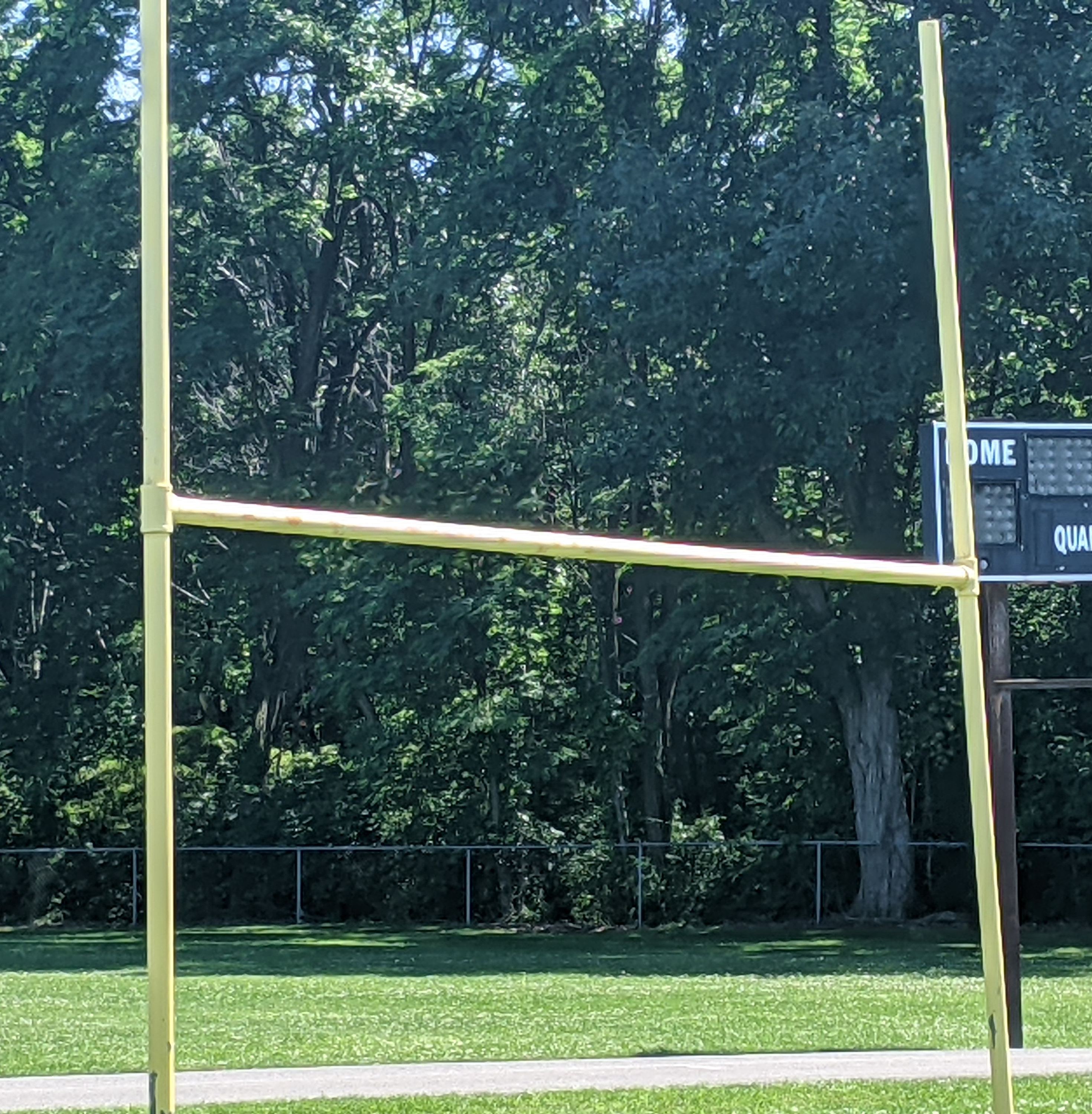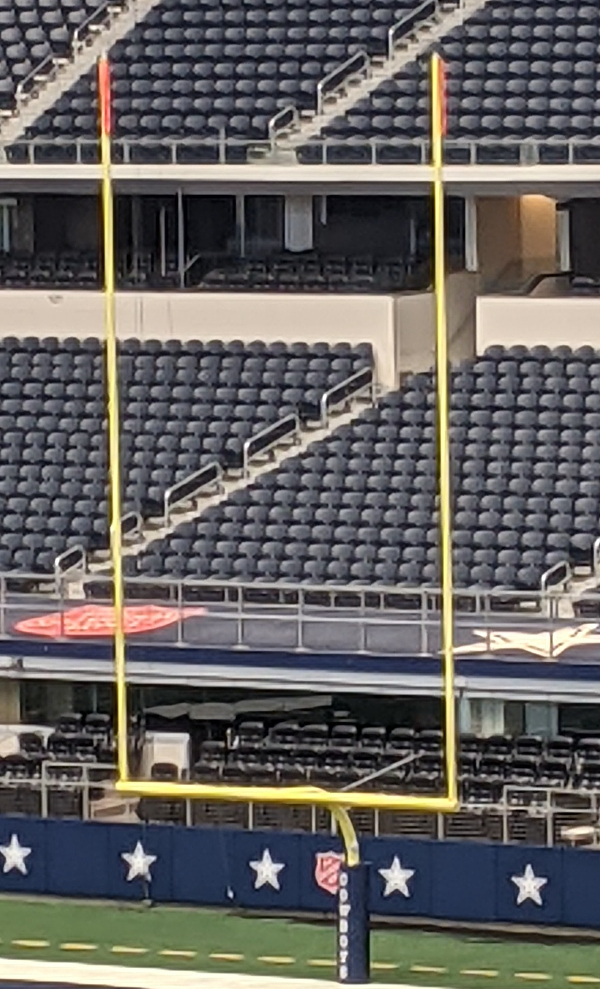One of the most iconic items in American and Canadian brands of football are the goal posts. These towering giants make a statement, they differentiate a football field from those of soccer, field hockey, lacrosse etc. They still can be found around the football world in a variety of shapes and sizes but where did all of this come from? The best place to start is at the beginning….
Goal Post History
Goal post history
The roots of the gridiron game as stated many times share the same path as soccer and rugby. One of the main objectives of the early predecessors of these games was for competitors to kick the ball at some sort of structure or goal at their opponent’s end of the field. These early games of the Greeks and Romans generally had the goal as being a boundary line of some sort. When the 7 major schools of England adopted adaptations of these games in the 12th Century the structures to shoot at started to appear in history. One of these was the School of Rugby.
At Rugby School their version of “football” differed from those of the rest of England, with the rule that players could hold and carry the ball in their arms. Legend has it that one player in 1823 disregarded the established rules, tucked the ball under his arm, and dashed across the goal of the opponents. By the 1830's, running with the ball at Rugby School was in common use and 18 foot goal posts had been added with a cross-bar at 10 feet above the ground. The innovation of the cross-bar was accompanied by a rule that a goal could only be scored by the ball passing over the bar from a place kick or drop kick. Apparently this was done to make scoring easier from further out and also to avoid the horde of defenders standing in and blocking the goal. These were the “H” shaped posts still found at many lower levels of football.

American influence on goal posts
When these games of Britain traveled across the pond to America, they were influenced and revised even further. A rules meeting on October 15, 1871 by the Princeton Football Association whereby they decided the field should be 500 feet in length by 300 feet in breadth ( over 166 yards long x 100 feet wide) and posts being 25 feet apart according to Parke H. Davis in his 1911 Football: the Intercollegiate Game.
The men of the Yale Football Association changed the field size once again in their October 31, 1872 meeting. They reduced the goal post width to 8 feet apart and the playing field was shrunk slightly to 400 feet (133.33 yards) long by 250 feet in breadth (84-⅓ yards wide) for its 20 players to a side. In each of these early renditions the posts were set on the goal line at each end of the field. The NFL in 1920 played by the college rules so they too had an H structure on each goal line. We must remember that the field goal was worth more than a touchdown at this time, so focus on the apparatus was extremely important to the game. In the 19th century a Field goal was worth 5 points while a TD was only 4.
In 1927 this scoring target device was changed for the very popular brand of the game of that era, the College level. The NCAA in 1927 applied a rule where the goal posts were moved from the goal lines, ten yards further back to the end lines. This may be the first instance of where the posts were found on the endline which is extremely common today in the United States. The NFL followed suit, as they were still using the NCAA rule book at the time. In 1933, the NFL started writing their own rule book and returned the sets of uprights to the goal line in an effort to encourage more scoring via field goals. This carried on for decades with the top two levels of football in America having the posts in different locations from each other.
The goal line placement of the H-shaped structures played a major role in at least one NFL title game, the 1945 NFL Championship. The game featured Washington with their star quarterback Slingin’ Sammy Baugh against a tough Cleveland Rams team led by their rookie sensation signal caller, Bob Waterfield. The two teams were not the only contestants in this game as the game time temperature of -8 degrees fahrenheit and the end line H's were found to be other opponents in the game as well.
An excerpt for the Game Before the Money website tells us this;
“Baugh threw from his own end zone early in the game. He had a wide-open receiver to his left, and that receiver had a blocker in front of him. Cleveland’s defense featured a 12th man, however. The goal posts knocked down Baugh’s pass. By 1945 rules, that counted as a safety for the Rams.”
The safety played a factor in the outcome as the cold temps aided in a low scoring affair with the Rams winning by the b=narrowest of margins, 15-14. It is interesting that some sports writers of the time listed the goal post as the games MVP.
In 1967 a change to the style of the goal posts was introduced. The “slingshot” style that is prevalent today in the NFL, NCAA and many other levels. According to an article on the Smithsonian Magazine they were inspired in a very unique and imaginative way;
“Today’s model, known for obvious reasons as “the slingshot” Goal post was first proposed in 1967 by Joel Rottman, a retired magazine and newspaper distributor and part-time inventor who came up with the idea while eating a steak lunch and noticing the prongs on his fork. As seen in Rottman’s patent, the original design called for 10-ft uprights. The uprights were extended at the request of NFL commissioner Pete Rozelle, who then agreed to allow their use in professional play. Within the year every NFL team was using the new slingshot uprights. “
Another story of Rottman’s inspiration was the curved street lights found in most neighborhoods and highways. Whatever the inspiring object was, Rottman’s idea was brilliant and really changed the goal posts forever. The first NFL title game to see the Rottman style posts was Super Bowl II.

A 1974 NFL rule revision, based on player safety, took the goal posts and moved them to the end line to match the college game. The game has been much safer since at all levels in the U.S.and the interference that they caused in the play of the game has been limited primarily to those in the kick for points attempt plays.


